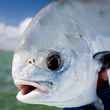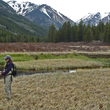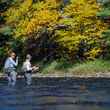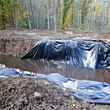Nobody likes being the nostalgic steelheader in the room, but increasingly I find myself as the gray haired guy at the table waxing poetic about how great wild steelhead fishing on Washington’s Skagit River used to be. You know, back in the “good ole days.” Getting on in years sucks and watching my beloved wild steelhead waters deteriorate even faster than me just adds insult to injury.
I’m not nearly old enough to have experienced the Skagit in its real heyday. Back at the turn of the 20th Century, guys with cane rods and silk lines waded waters that boasted a return of 150,000 wild steelhead. By the time I was swinging a fly rod on the Skagit, the number of annual metalheads had plummeted down to around a high of 13,000.
That is a crazy notion for me to wrap my head around. For me, the “good ole days” were less than ten percent of what they were for my grandfather’s generation. Even crazier is that, by the time my oldest son was grown enough to first cast for chrome in the Skagit, the river’s returned had dropped to about half the number of fish I had first experienced a generation earlier.
Fortunately, since then, a myriad of positive developments—the Endangered Species Act (ESA) listing of the Skagit’s wild steelhead, a suite of collaborative habitat restoration projects by groups ranging from the Skagit River System Cooperative to the Wild Steelhead Coalition, reduced angling pressure, and a lawsuit that halted hatchery releases—have contributed to a guarded reound of the Skagit’s steelhead. After decades of continuous decline, the Skagit’s wild steelhead population has risen from its nadir of 2,502 fish in 2007 and over the last six years has averaged an estimated run size of approximately 7,876 wild steelhead (that number did slip in 2017 down to about 6,700).
Now that the Skagit’s wild steelhead population has “recovered,” the National Marine Fisheries Service (NMFS) has put together a proposed plan to reopen the late-winter and spring wild steelhead fisheries in the Skagit watershed. This development has created a tidal wave of excitement as the Skagit’s long list of lovers line up to reap the benefits of the river’s resurgence. These days you cannot walk into a fly shop in the Puget Sound watershed without hearing conversations about planned spring Skagit trips once the river reopens.
Amidst all of the fervor around reopening the Skagit are the voices of handful of folks, like myself, who are advocating precaution and positing this thought: Are we asking the right questions? If you read NMFS’s proposed plan, it is basically seeks to answer the question: How much pressure can we place on this fishery and still be confident the population does not go extinct in the next century? Essentially, it proposes a maximum sustained yield approach with a bit of a conservation buffer.
Are we sure we want the answer to that question to be the guiding management approach for one of the most iconic steelhead rivers in the world? Do we really want the primary management objective for Skagit River steelhead to be maximizing recreational and commercial angling opportunity while hoping to stave off extinction? Is that how we should be thinking about all our steelhead fisheries in Washington? Or are we better served with a management strategy that prioritizes the continued recovery of Skagit wild steelhead and creating a world-class fishery?
I understand the urges of my fellow anglers, who like me, grew up living in sync with the Skagit River’s salmonid runs, to once again wade into its waters in the spring and swing for steelhead. But before we all race to the river with gold rush fever, we should pause to ask a dfferent question: What do we want the Skagit to be?
I am confident that my answer to that question aligns with that of almost every steelheader in the state of Washington: We want more wild steelhead. We want bigger wild steelhead. We want to be able to spend a day on the water without feeling like we are partaking in a fishing rodeo. We want reliable fishing seasons. We want a river that gets healthier and fishier every year. And we want the pride of knowing our homewater is one of the best steelhead fisheries anywhere in the world.
Transforming our most heartfelt wishes into a reality is possible, but the NMFS’s proposed management approach works against those desires. Yes, we all want to fish the Skagit in the spring again, but why are we selling out our long-term wishes and self-interest just to get out on the river sooner and more often?
We have an incredible opportunity to continue recovering the Skagit’s wild steelhead and help the river reclaim its mantle as one of the world’s best steelhead rivers. And with conservation-oriented regulations and appropriate monitoring and enforcement, we can do all of that while fishing through recovery.





























Comments
Bert Brehm replied on Permalink
Rich,
A river with lots of fish will always be targeted for harvest -- legally or otherwise. Without any data to back me up, I have always wanted to believe that people on the water are the best way prevent poaching. The State doesn't have the resources to monitor all the rivers all the time so more eyeballs with cell phones could be part of the solution.
Do you have any percentages or numbers for poaching? For open or closed waters?
Jon Tobey replied on Permalink
Thank you for writing this. So many people I respect, including noted conversationalists, are all for opening this river. The argument I heard the most when I posted about this was that "the river is now sustaining the maximum amount of fish it can sustain." But when I read your numbers that's ~5% of the historical total and I agree that we are definitely answering the wrong questions. How do we know it's at "maximum capacity" is true if we don't leave the river alone? I have a feeling that like with the Elwha, Nature might surpass some slide rule calculation. If anything, this experiment has shown we should ban hatcheries and close all of the rivers for a while. I could see a rolling ban on the S rivers, one river closed at a time for a minimum of 5 years.
I agree, we should focus on the fish first, and worry about the fishery later, even if that is not in our personal short term interest, it seems the only way we might leave something, anything, for our sons and daughters.
Confused Reader replied on Permalink
This article fails to actually state anything of purpose or fact. It is all a bunch of random musings pieced together based on little to no scientific backing in a veiled effort to support .org's. The author cites fish count numbers but refuses to acknowledge or question why their was variance in those very numbers. The author never once mentions ocean nor river conditions (floods) that directly contributed to and caused the dip in the run size, but instead talks about hatchery runs.
If we were to use this uninformed author's logic, then we can hang our hat on the fact that run size doubled after a year in which a C&R season as in place and hatchery smolts were released (09). I would love to see the run size double each year, so lets open it for C&R and pump out hatchery fish!
See how crazy that sounds?
Science is, and should be, based on facts and data, not uninformed opinions like this article. Very surprised to see this posted by what is typically a decent source of vetted content.
Zeek replied on Permalink
I completely agree with the post above about this not being based on science and completely taken out of context to promote one's agenda. Rich Simms is completely against hatchery fish which have nothing to do with wild fish on the Skagit and Sauk Rivers. He makes a living by suing the Washington Department of Fish and Wildlife. He has single-handedly ruined Fisheries for all of us in Washington while lining his pockets with hard-earned taxpayer dollars.
Fish Stalker replied on Permalink
There’s no evidence C&R fishing limits fish populations. Tribal gillnetting will always keep the runs from significantly rebounding anywhere in Washington, no matter how many habitat improvements are made or how little sportsmen get to fish. This article seems like it’s been written by someone who lives in a fantasy world that bears little resemblance to reality.
Pages